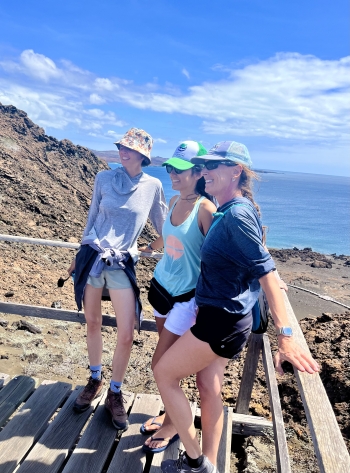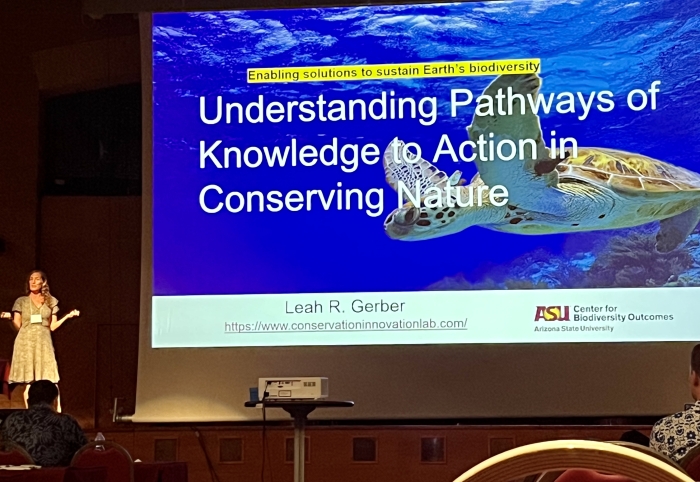ASU researchers incorporate data into decision-making for conservation efforts

Stock photo
Leah Gerber sees conservation as a crisis discipline — the work involved tends to be reactive, with the engaged decision-makers rapidly basing their guidance on the available information.
“When you go into an emergency room, the doctor doesn’t say they need to collect more data. The doctor takes action and relies on what they already know works. We don’t have that luxury in conservation, but that’s what we’re working toward," said Gerber, founding director of the Center for Biodiversity Outcomes (CBO) and a professor in the School of Life Sciences at Arizona State University.
"CBO," she said, "is building that basis for making decisions based on what we know works. That’s the role of data in decision-making.”
Gerber recently collaborated with Gwen Iacona, the program lead for conservation investment at CBO, on a curated collection for the Public Library of Science (PLOS) that addresses the disconnect between data and decision-making.
“Conservation is a human decision-making problem,” wrote Gerber and Iacona in their introductory editorial. “Most human choices impact biodiversity outcomes, and conservation success depends on what we identify as important and the decisions we make to achieve stated goals.”
“We have a lot of uncertainty about the status of species and ecosystems, and understanding which interventions work to address which problems,” Gerber said. “That’s one of the biggest challenges in conservation. By systematically synthesizing data on the threats, the responses to the best available evidence on which intervention works for different types of threats and the costs of these interventions, we can be much more efficient in achieving better outcomes based on, or even independent of, limited resources.”
The framework for this collection originated from a conversation at the Gordon Research Conference in Italy last year. After giving the plenary talk, Gerber was approached by the editor of PLOS about contributing to a biodiversity-focused series. Over time, the concept shifted to align closer with her work on decision-making.
The other papers in the collection were curated to represent the different dimensions of this challenge and incorporated a diverse array of voices from around the world that represent academia, nonprofit organizations and funding entities. Gerber’s hope for this collection is to open up the discussion around addressing the extinction crisis and to better define the role that data plays in science.
“Data, models, analytics and other tools can provide concrete material for deliberative decision processes,” she said. “Just putting the data out there isn’t going to lead to anything, but bringing these tools into the discussion allows us to be transparent about the work we’re doing. This also enables us to make decisions that are most likely to achieve our desired outcomes, based on quantifiable information.”
This closely aligns with the overall mission of CBO.
“Part of our motivation for the center is to cultivate innovation by bringing together different disciplines to address the extinction crisis, and then to integrate that scholarship into the outside world with organizations like corporations, governments and NGOs to achieve biodiversity outcomes,” Gerber said.
Gerber referenced the Endangered Species Act as an example of the practical intersection of data and decisions. Currently, only about 20% of the actions outlined in species recovery plans are receiving funding, and the species are not recovering as hoped. Despite these challenges, researchers are looking for positive outcomes — and this is where data can help.
By compiling information on what has worked so far, and what is cost-effective, researchers can equip decision-makers with the tools they need to make choices in the face of complexity. Gerber notes that data shouldn't necessarily override social, policy and other more subjective factors that influence these decisions, but having evidence for decision-makers to reference can increase transparency about how these decisions are made. This can also help resolve some of the disconnects between the research being done and the needs of the community.
Often, published research isn’t accessible to the public, and even when it is accessible, it isn’t always relevant to the challenges facing the local communities. To address this, Gerber said it is crucial to build decision structures that incorporate a variety of voices. Understanding the needs for research, she said, can help align the data and tools with those needs, assist in capacity building and ultimately develop a more effective way to approach conservation.
More Environment and sustainability

Majority of American religious leaders silently believe in climate change, ASU study shows
Many Americans turn to religious leaders for guidance on matters of faith and morality.With this in mind, a new study, led by a researcher from Arizona State University, suggests that congregations…

A prototype of a university for a thriving world
The challenges for our world’s health and the future of humanity and other life-forms command urgency — and the university is accelerating its wide-reaching collaborative work to help keep the planet…

From K–12 to corporate upskilling, ASU guides learners of all ages to design a sustainable future
Editor’s note: This story is part of a series exploring how ASU tackles complex problems to create a thriving future.When Kennedy Gourdine was a high school student in Maryland, she conducted…



